
Asana vs monday vs ClickUp: Complete Project Management Comparison 2026:
Summary: This blog compares three popular project management tools: Asana vs monday and ClickUp. It explores their strengths and weaknesses across critical areas like task management, collaboration, templates, integrations, customization, and workflow automation. By examining these aspects, the blog helps you determine which platform best suits your team’s needs, whether you prioritize flexibility, simplicity, or robust features for complex projects.
With 46% of organizations listing project management as crucial, prioritizing effective planning is essential. It sets the foundation for meeting deadlines, staying within budget, and achieving project goals. Without a clear roadmap, even the most talented teams can struggle to meet deadlines, stay within budget, and achieve their goals.
Regarding project management tools, finding the right one can make or break your planning process. This blog will compare the three most common project management tools — Asana monday.com, and ClickUp.
Each offers unique features and capabilities, but which one truly stands out? We’ll dive into their strengths and weaknesses to help you determine which tool is the best fit for your team’s needs.
Whether you are looking for project management space, collaboration, or overall efficiency, this guide will provide the insights needed to make the right decision.
How We Analyzed and Compared Both These Platforms?
To analyze and compare Asana, monday.com, and ClickUp, we relied on user reviews from platforms like G2, Capterra, and Reddit. These sources provided insights into user experiences, highlighting each tool’s strengths and weaknesses. To compare them comprehensively, we focused on key aspects like task management, collaboration, templates, integrations, customization, and workflow automation.
Asana vs monday vs ClickUp at a Glance
When choosing the right project management software, it’s essential to understand how different tools compare. Asana, monday.com, and ClickUp are among the most popular options, each offering unique features tailored to various project management needs. Here’s a quick comparison to help you decide which platform best suits your team’s workflow and goals.
| Features | |||
|---|---|---|---|
| Free Storage | 500 MB | 100 MB | 100MB |
| Collaboration | Comments on tasks, shared boards, file attachments | Comments on tasks, team discussions, @mentions | In-app chat, comments, and document sharing |
| Integration | 200+ integrations, ideal for flexible workflows | 200+ native integrations with popular tools | 1,000+ integrations, best for extensive needs |
| Automation | 250 automation/month on the standard plan; more on higher plans | 250 action/month on the starter plan; more on higher plans | 100 automation/month free; more on higher plans |
| Time Tracking | Built-in feature with advanced time tracking | Built-in feature | Built-in time tracking |
| Task Dependency | It offers the option to add a dependency column and automate workflow. | Built-in feature to designate tasks | Advanced task dependencies features |
| Ease of Use | Simple design and easy to use with customizable views | Traditional interface with a steeper learning curve | It has a complicated interface, often confusing |
| Reporting | Extensive built-in reporting tools and dashboards | Limited built-in reporting; third-party plugins needed | Detailed analytics and reporting capabilities |
| G2 Ratings | 4.7 Stars | 4.4 Stars | 4.7 Stars |
| Try monday.com for Free |
What is monday.com?
monday.com is a work operating system (Work OS) designed to streamline project management, team collaboration, and workflow automation. Launched in 2012, it caters to businesses of all sizes, focusing on customization and flexibility.
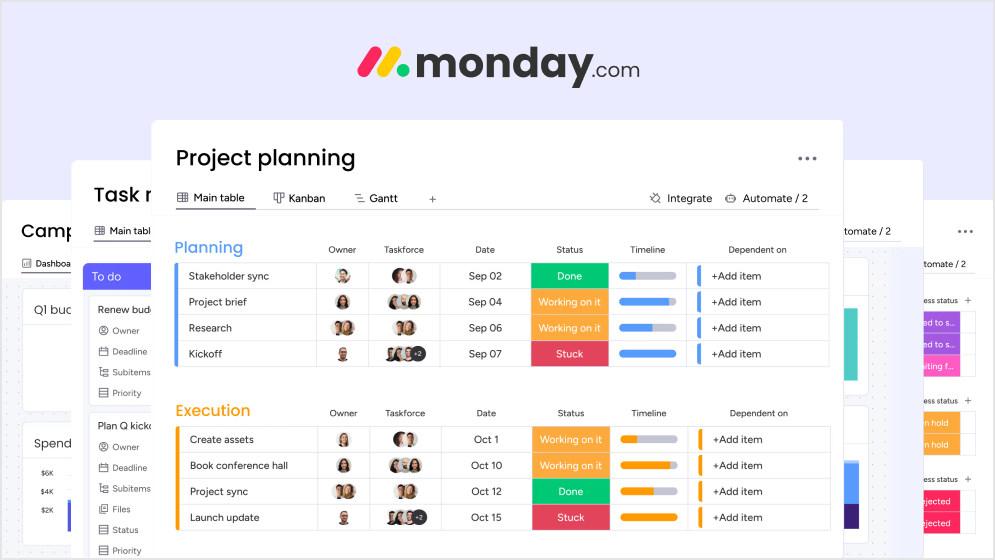
monday.com allows users to manage projects from various viewpoints, such as Kanban boards, Gantt charts, and calendars. Its strength lies in its ability to offer over 200 customizable templates, no-code workflow automation, and integrations with popular tools like Slack, Google Drive, and Salesforce.
Here are some popular features of monday.com:
- Customizable dashboards
- Multiple project views
- No-Code workflow automation
- 25,000 actions per month for integrations
- 200+ customizable templates
These features allow teams to tailor the platform to their specific needs, making it easier to manage projects, track progress, and automate repetitive tasks. The integrations ensure seamless communication and data sharing across different tools, enhancing productivity and collaboration.
What is Asana?
Asana is a collaboration and project management platform that helps teams plan, organize, and track work. Founded in 2008, Asana is designed to enhance productivity by offering various project views, including lists, boards, calendars, and timelines.
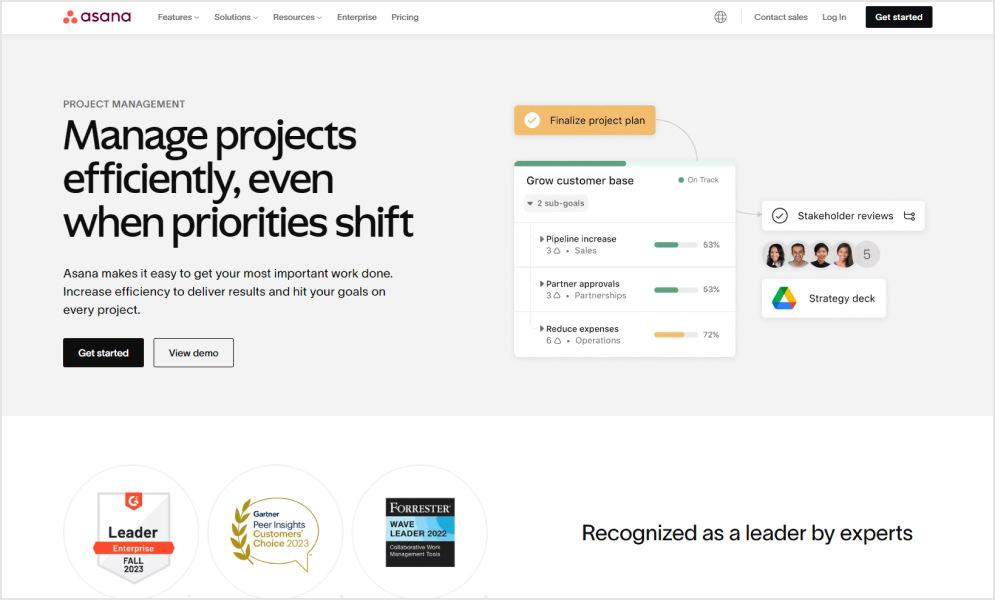
It supports task management with features such as task creation, assignment, dependencies, and deadlines. Asana also integrates with numerous third-party applications, such as Slack and Microsoft Teams, facilitating seamless communication and collaboration.
What is ClickUp?
ClickUp is an all-in-one project management software that aims to replace multiple productivity tools with a single solution. Founded in 2017, ClickUp offers comprehensive features, including task management, goal tracking, document collaboration, and time tracking.
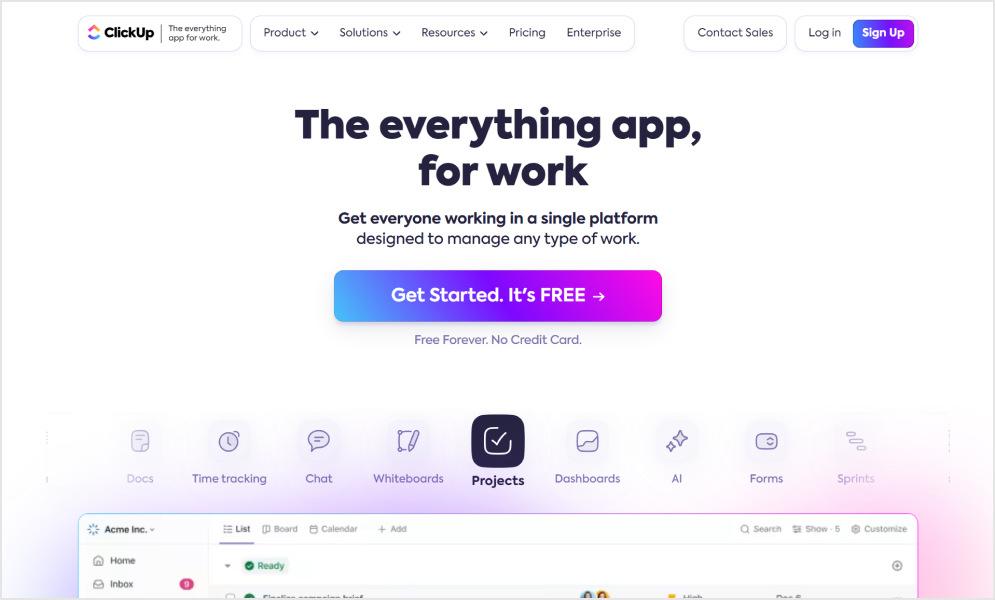
ClickUp stands out with its extensive automation capabilities, allowing users to streamline repetitive tasks and workflows. With over 1,000 integrations available through native connections and Zapier, ClickUp is designed to accommodate a wide range of team needs.
Get More Done with Less Effort
Our experts help you maximize productivity and streamline workflows with ease.
Detailed Comparison: Asana vs monday vs ClickUp
This detailed comparison explores Asana, monday.com, and ClickUp, focusing on their unique features and capabilities. Asana excels in task management and project tracking; monday.com offers customizable workflows and automation, while ClickUp stands out for its simple, visual board-based approach. Discover which tool best suits your project management needs:
1. Task Management
Asana provides comprehensive task management features, including options to create tasks and subtasks and assign deadlines. Users can view tasks in List, Board, Calendar, and Timeline (Gantt) formats. Asana also supports task dependencies, making it easier to manage complex workflows.
monday.com uses “Pulses” for tasks, which can be customized with columns showing status, priority, and deadlines. It offers a visual overview of tasks across various views, such as Kanban, Gantt, and Calendar.
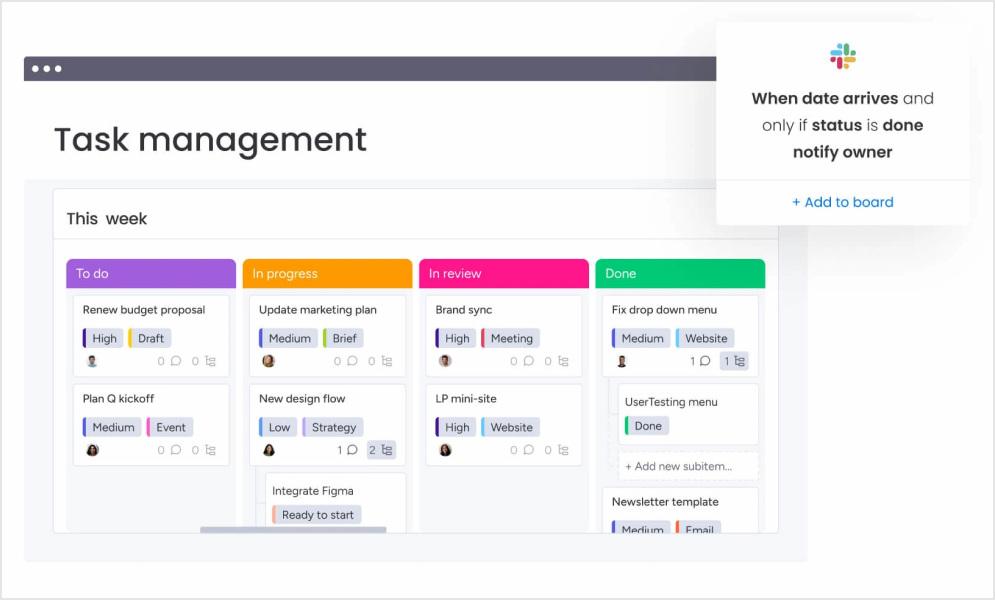
ClickUp excels in task management with its hierarchical structure, which allows for tasks, subtasks, and checklists. It offers detailed task views with features like task dependencies, priorities, statuses, and time estimates. ClickUp also supports multiple views, including List, Board, Calendar, and Gantt.
2. Collaboration
Asana supports collaboration through task comments, project message boards, and integrations with tools like Slack and Microsoft Teams. However, it lacks built-in document collaboration and an online whiteboard, requiring third-party tools for these functionalities.
monday.com offers robust collaboration features, including task commenting, a shared calendar, document collaboration, and an online whiteboard. It enables teams to communicate within tasks and projects, ensuring transparency and ease of collaboration.

ClickUp provides extensive collaboration tools, including task comments, mentions, chat, and document collaboration. It also has a built-in feature for assigning comments as tasks, which enhances collaboration and accountability within teams.
3. Templates
Asana offers a limited selection of templates for project management, task tracking, and team collaboration. While the variety is not as extensive as that of other project management tools, the templates are user-friendly and cover essential project management needs.
monday.com offers over 200 customizable templates for various use cases, including project management, CRM, marketing campaigns, and software development. These templates can be adjusted to fit specific team needs.
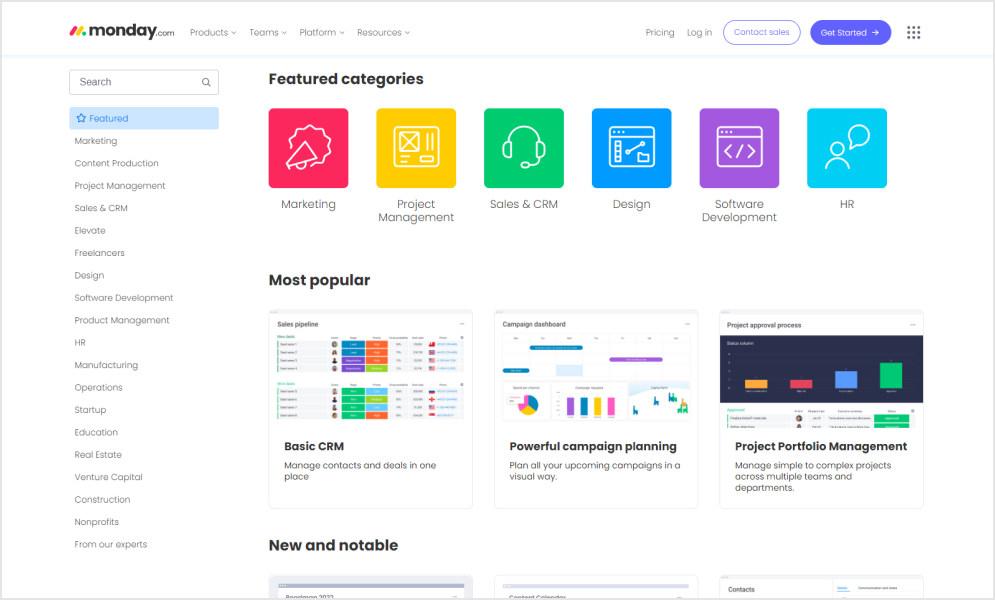
For example, a product development team can use the “Product Launch” template to track market research and design tasks. They can tailor this template by adding specific stages, integrating with CRM tools, and setting up automation for task notifications.
This customization helps the team with efficient project management and keeps them organized throughout the launch process.
ClickUp provides various workflow templates, including project management, task tracking, and Agile development. Users can also create custom templates to standardize processes across teams.
4. Integration
Asana offers over 150 integrations with tools like Microsoft Teams, Slack, Zoom, Google Drive, and Salesforce. These integrations make connecting with a wide range of third-party applications easy.
monday.com supports more than 200 integrations with popular tools like Slack, Zoom, Google Drive, Shopify, and Salesforce. Its integrations are customizable, allowing users to tailor functionality to their needs.
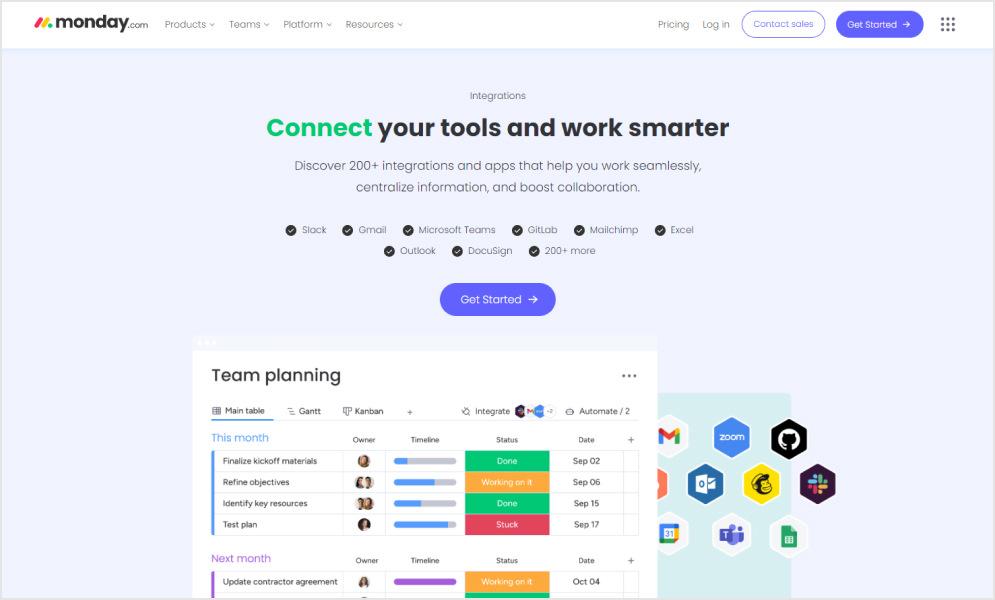
TaskRhino specializes in enhancing your monday.com experience by providing expert integration services tailored to your business needs. Whether you’re looking to manage tasks across various platforms or streamline workflows, TaskRhino helps you seamlessly connect monday.com with the tools you rely on.
ClickUp boasts over 1,000 integrations through its native offerings and Zapier connections. It integrates with many tools, including Slack, Google Workspace, Zoom, GitHub, and Trello, making it highly versatile.
5. Customization
Asana offers moderate customization options, including custom fields, tags, and project views. While it is flexible enough for most teams, it may offer a different level of customization than ClickUp or monday.com.
monday.com is highly customizable. It allows users to create custom workflows, dashboards, and automation without coding. It also offers flexibility in designing boards and views to match specific team processes.
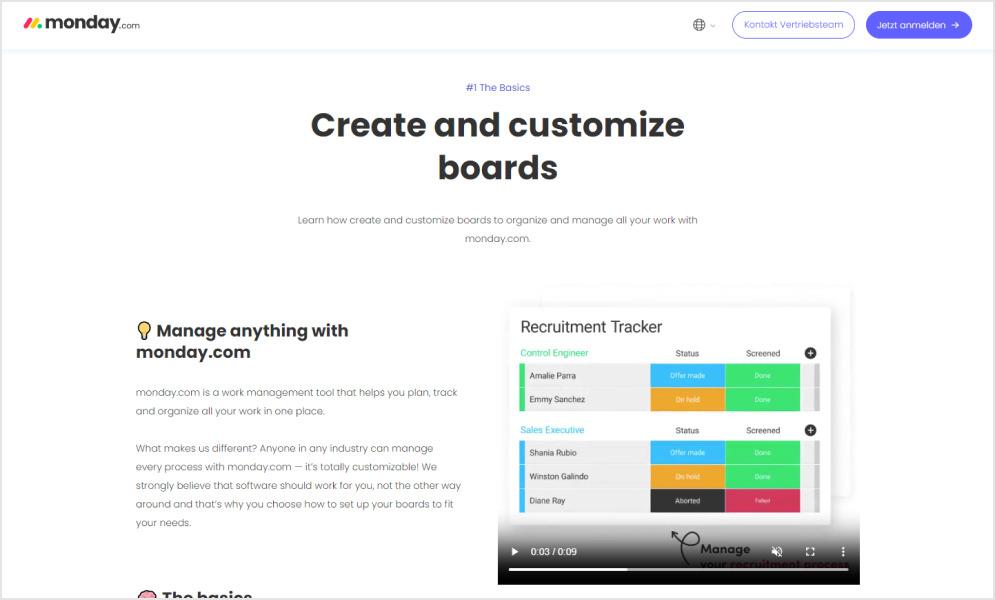
ClickUp is one of the most customizable project management tools. It offers flexibility in task creation, views, statuses, and workflows. It also allows for custom fields, automation, and dashboards, making it adaptable to various team needs.
6. Workflow Automation
Asana offers basic workflow automation through its Rules feature, which allows users to automate task assignments, due date adjustments, and notifications. While useful, its automation capabilities are not as advanced as those in monday.com or ClickUp.
monday.com excels in workflow automation with its no-code automation builder. Users can automate routine tasks, such as task assignments, notifications, and status updates, streamlining workflows and improving efficiency.
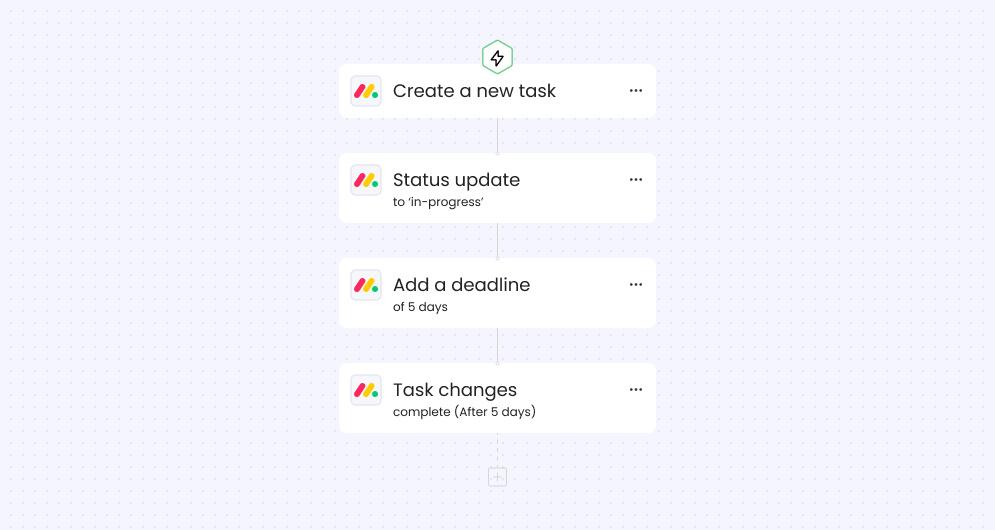
For example, a marketing team can set up an automation to automatically assign new tasks to team members based on task type, update task statuses when conditions are met, and send notifications as deadlines approach. This automation helps eliminate manual updates, ensuring tasks are efficiently managed and team members stay informed, thus improving overall productivity.
ClickUp provides robust automation features, allowing users to automate repetitive tasks, status updates, and notifications. Its comprehensive automation capabilities cater to complex workflows with multiple triggers and actions.
7. Reporting & Dashboard
With Universal Reporting, Asana provides customizable dashboards and project views, such as the overview and dashboard view. Users can track task progress, assignee updates, and project statuses.
However, its reporting capabilities are somewhat limited in customization compared to other tools, and advanced features are only available on higher-tier plans.
monday.com offers a variety of dashboard widgets and integration capabilities. It allows users to create comprehensive reports with custom views, and its strong integration options support merging multiple workspaces into a single dashboard.
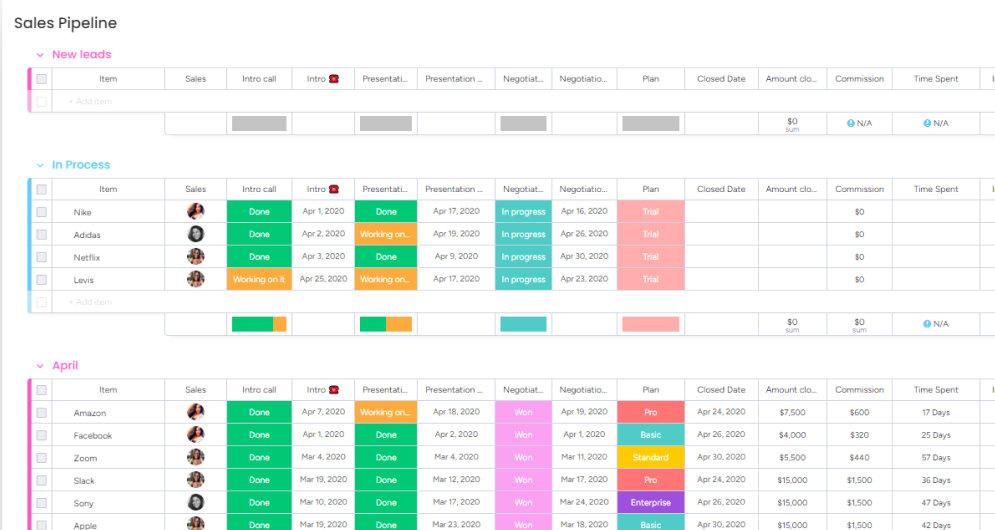
ClickUp excels in reporting with highly customizable dashboards and real-time analytics. It provides over 50 card variations for dashboards, offering detailed insights into project performance, time tracking, and resource utilization.
ClickUp’s goal-tracking features are concrete and available even on the free version. It integrates data from the entire workspace, making it easy to see all relevant metrics in one place.
8. Ease of Use
Asana is known for its user-friendly interface and intuitive design, which makes it easy for new users to get started quickly.
The platform features a clean, visually appealing layout with simple navigation. Its task management features, such as drag-and-drop functionality and customizable task fields, streamline project organization.
However, some users may find that its advanced features and customizations require a steeper learning curve, particularly when managing multiple projects or using integrations.
monday.com offers a highly visual and customizable interface that simplifies task management and team collaboration. The platform uses color-coded boards and widgets to make tracking project progress easy at a glance.
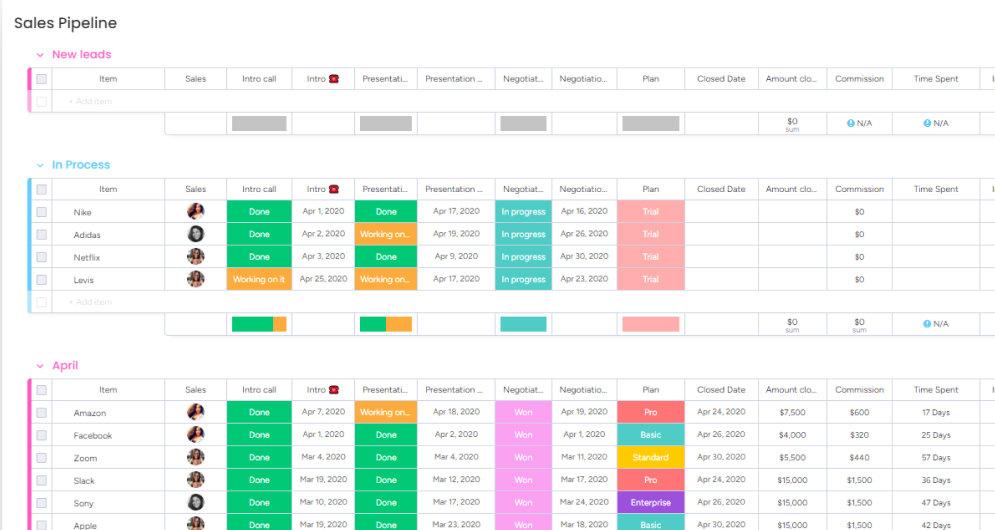
The all-in-one solution also offers a no-code automation builder and template library, further enhancing ease of use by allowing users to automate routine tasks and quickly set up workflows tailored to their needs.
ClickUp provides a comprehensive range of features within a single platform, which can be both a benefit and a drawback regarding ease of use. The interface is highly flexible, offering multiple views like lists, boards, and Gantt charts.
While this flexibility allows for advanced customization, it can also lead to a more complex user experience, particularly for new users of the platform.
ClickUp’s learning curve is somewhat steeper due to its vast array of features and options, but it offers detailed help resources and tutorials to help users master the tool.
9. Security
Asana provides security features, including two-factor authentication (2FA) across all plans, which is essential for protecting user accounts. For enterprise-level security, Asana offers Security Assertion Markup Language (SAML) for single sign-on (SSO) and user provisioning/de-provisioning, along with a 99.9% uptime guarantee.
However, Asana’s Enterprise plan does not include IP restriction capabilities, which can be a limitation for IT teams seeking more control over device access.
monday.com also includes two-factor authentication (2FA) on all plans, ensuring high account security. For enterprise users, monday.com offers additional security features such as IP restriction capabilities, providing IT teams greater control over device access.
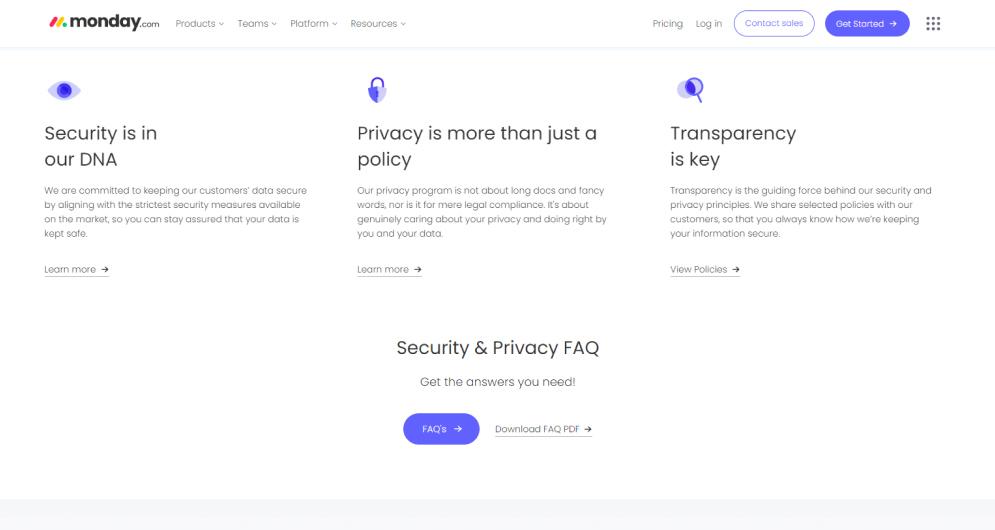
monday.com includes Security Assertion Markup Language (SAML) for single sign-on (SSO) and user provisioning/de-provisioning. It also promises a 99.9% uptime and offers this in its Service-Level Agreement. Notably, Monday.com encrypts and backs up data every hour, adding an extra layer of protection.
ClickUp takes security seriously, offering server-side encryption, two-factor authentication (2FA), advanced permissions, and single sign-on (SSO) on its ‘Business’ and ‘Enterprise’ plans.
ClickUp scores highly for security, although slightly lower than monday.com, with a rating of 4.4/5. Unlike Monday.com, ClickUp does not offer IP restriction services on its Enterprise plan. Despite this, ClickUp’s security measures are comprehensive and protect data well.
10. Pricing Plans
| Pricing Plans | |||
|---|---|---|---|
| Basic/ Personal | Free Price (per seat/month, billed annually) | $9 Price (per seat/month, billed annually) | – |
Starter/ Standard/ Unlimited | $10.99 Price (per seat/month, billed annually) | $12 Price (per seat/month, billed annually) | $7 per user/month |
| Advanced/Pro/ Business | $24.99 Price (per seat/month, billed annually) | $19 Price (per seat/month, billed annually) | $12 per user/month |
| Enterprise | Contact Sales | Contact Sales | Contact Sales |
| Try monday.com |
Asana, monday.com, and ClickUp all have a free version with essential features. Users can access basic task management, project tracking, and collaboration tools, including task assignments, due dates, and project views. However, advanced features such as timelines, reporting, and integrations are reserved for paid plans.
Asana vs. monday vs. ClickUp Review
We turned to Reddit to gauge opinions on the Asana vs monday.com vs ClickUp debate. A search for the best project management tool on Reddit reveals that many users appreciate Asana’s extensive integrations as a significant advantage.
“Asana is good but lacks some of the logic if you are managing large and complex projects. On the other hand, it interfaces with simply everything.”
Others note that monday takes the upper hand on pricing and UX:
“For me, monday.com takes the lead in the pricing and interface comparison.”
On the other hand, ClickUp users feel it is incredibly complicated:
“My current clients are using Asana & ClickUp. Asana is pretty easy to navigate and minimalistic in design, while ClickUp is way more complex and perfect for highly organized people.”
Reddit users weigh in on the Asana vs monday vs ClickUp debate, highlighting Asana’s extensive integrations, monday.com’s favorable pricing and user interface, and ClickUp’s complexity, which suits highly organized teams but may be overwhelming for others. Each tool has its strengths, depending on user needs and project complexity.
The Real Question: Is Asana, monday, or ClickUp?
This review of Asana, monday.com, and ClickUp highlights that no tool is perfect; each has unique strengths and weaknesses. Choosing between these best project management tools depends on your needs and preferences.
monday.com excels in customization and collaboration, making it ideal for teams that need flexibility and advanced team collaboration tools.
Asana offers a balanced approach with strong task management and integration capabilities, making it a good fit for teams that prioritize a simple project management platform. Meanwhile, ClickUp is a powerhouse in task management and automation, suitable for teams with complex needs.
However, the right project management tool depends on your unique needs. This guide is designed to help you understand the Asana vs monday.com vs ClickUp comparison. If you’re exploring Asana alternatives, or want to dive deeper into project management software before choosing, here’s an extensive guide to help you find the perfect solution for your team.
Looking for a Better Alternative?
Transform your team’s productivity with monday.com!
Frequently Asked Questions
What’s better, ClickUp or monday?
If you’re deciding between monday.com and ClickUp, monday.com is generally the better choice due to its comprehensive feature set and scalability. Its advanced capabilities and integrations make it ideal for larger teams and multiple projects. However, for smaller teams that don’t require all the features of monday.com, ClickUp might be sufficient.
Why choose monday over Asana?
monday.com offers a highly customizable interface and a wide range of templates tailored to fit various workflows and project needs. Its visual approach and flexibility in building dashboards and automation make it suitable for multiple projects. Additionally, monday.com provides robust integrations with other tools and advanced reporting features, which can enhance overall project management and team collaboration.
Is ClickUp the same as Asana?
ClickUp and Asana are similar in that they are project management tools but have distinct features and approaches. ClickUp is known for its extensive features, including task management, goal tracking, time tracking, and customizable views. On the other hand, Asana offers a more streamlined approach, focusing on task and project tracking, team collaboration, and workflow management.
Are ClickUp and monday the same?
ClickUp and monday.com are project management tools but have different strengths and features. ClickUp is known for its versatility and extensive features, including task management, time tracking, goal setting, and customizable workflows. monday.com, on the other hand, excels in its visual project management interface, ease of use, and customization options. It offers a range of templates and integrations, making it suitable for teams looking for a highly adaptable platform. We ensure to protect the sensitive data by signing NDA with our clients and developers who will work on the project. As we know the importance of the sensitive information of your software, we follow the utmost level of security protocols to keep your project information safe and secure.
What is better: ClickUp, Asana, or monday?
monday.com offers a highly customizable and visually appealing interface, making it suitable for teams that need flexibility in their project management approach. ClickUp is ideal for users who need a versatile, all-in-one tool with extensive features like task management, time tracking, and goal setting. Asana is best for teams looking for a streamlined and intuitive platform focused on task and project tracking. It’s well-suited for teams prioritizing simplicity and ease of use over extensive customization.
Why do you need project management software?
Project management software is essential for planning, organizing, budgeting, and monitoring project progress. It consolidates team efforts toward shared goals, ensuring everyone works cohesively toward successful project completion. For dispersed teams, expanding businesses, or projects involving multiple departments, such software provides a unified platform that team members can access from any device, anytime, enhancing coordination and efficiency.
Editor's Choice
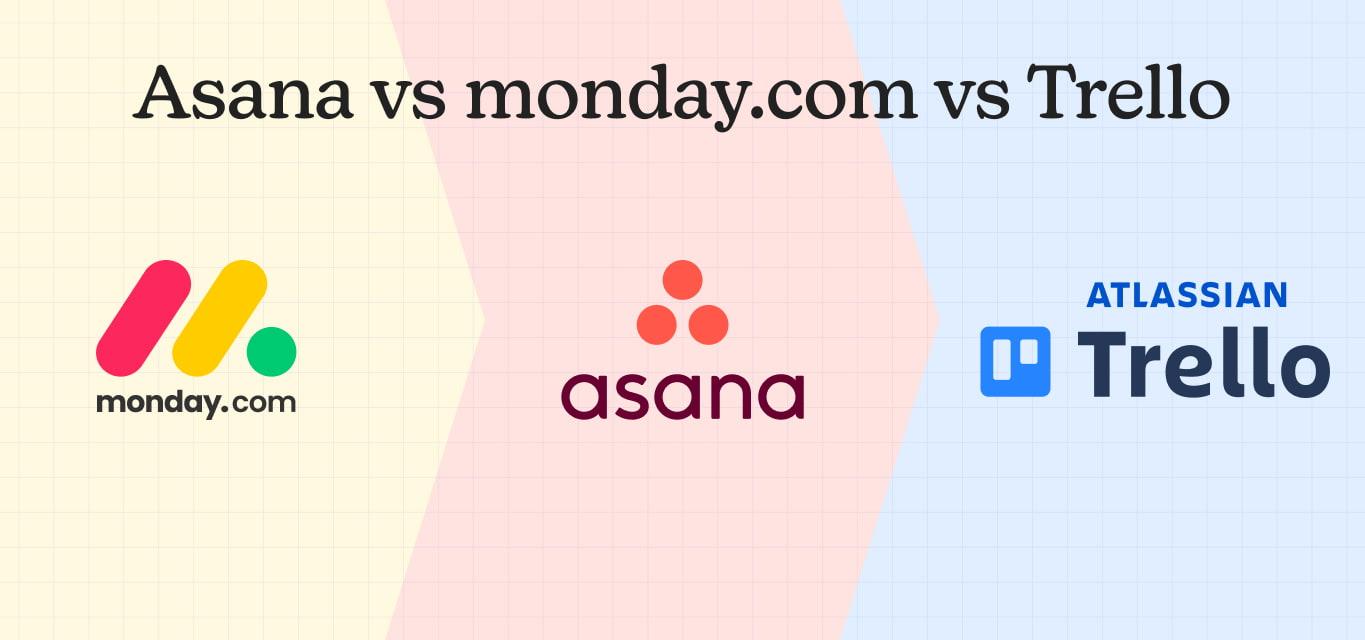
Asana vs monday vs Trello: Complete Comparison Guide 2026
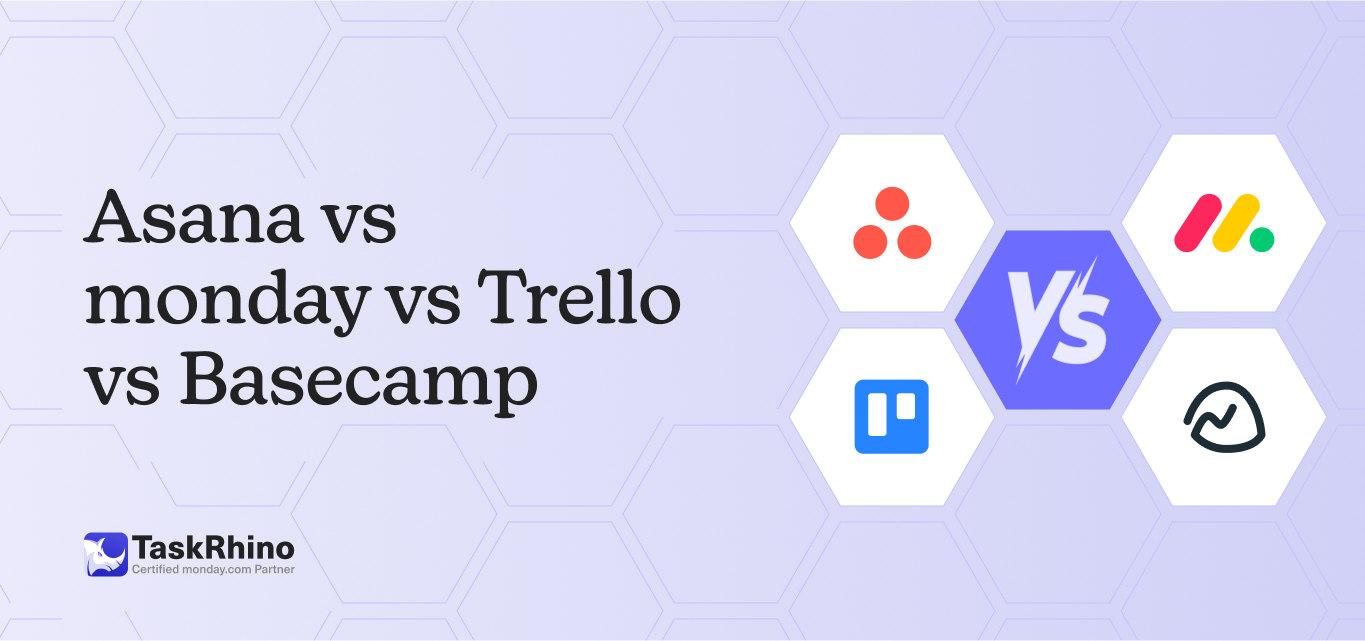
Asana vs Monday vs Trello vs Basecamp: Complete 2026 Comparison Guide
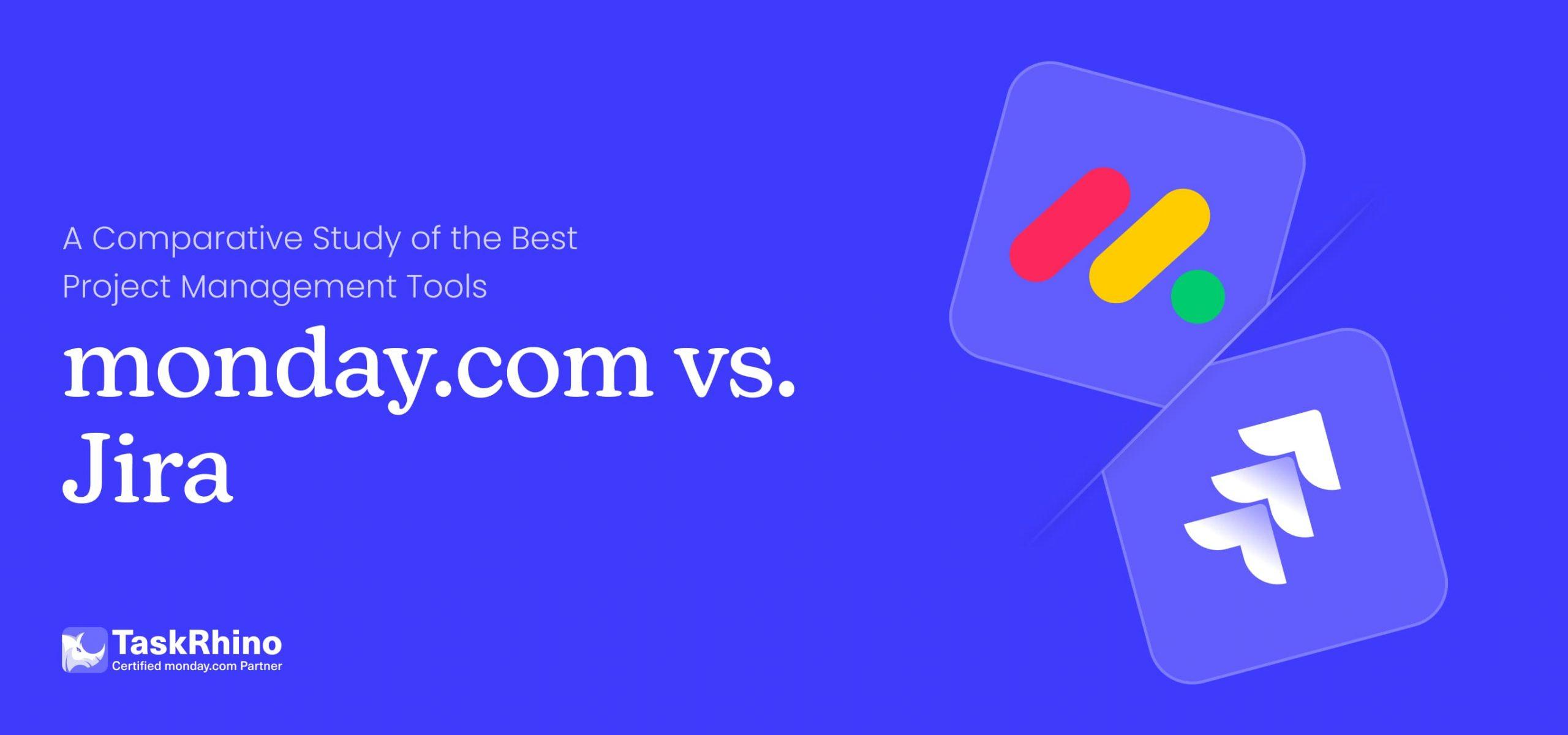
monday vs Jira 2026: Complete Feature Comparison & Decision Guide
